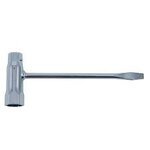I watched that video last night , or some of it, got exasperated, registered, made that comment, went to bed, thought more about it. Morning now.
I'll just add that no sane orchardist would top-work a tree like that. You top-work a tree by selecting the branches you need to keep, then graft them over to the cultivar you want. Easier, quicker, and far far more structurally sound. Why would anyone remove branches like
that, then try to add branches , which are far more likely to not have a strong crotch than the existing branches.
Hello Figless, We came here in 1977 to a forest block, cleared about twenty acres for an orchard, built a cabin, shed, cattle yards for a small cattle herd grazing the grass understory of the forest. Grew and sold fruit for twenty years, then changed over to plant production ,so built shadehouses for that. We have a smaller orchard now in the homestead area. The older orchard is not watered now, only slashed once a year, but we still get plenty of fruit from it from the hardier trees. We have about seventy different mango cultivars in the older orchard, and I've got interested in trying different figs, which is why I found this site. In the homestead area we have quite a few Ficus opposita growing, as they are native to this block. It has a deep tap root and handles dry periods well, so I'm grafting over branches of them to different F.carica cultivars. Also have planted some F. coronata , and the grafts on it are doing well so far. We're semi- retired now, and were only ever a small scale operation. We grafted all sale and stock trees ourselves. Busy life, but didn't photograph most of it.
I mainly do side veneer or side bark grafts when I top-work, as the stem above the graft is very useful to tie to the shoot from the graft , to prevent wind-breakage until the graft union is strong. It can be cut back to about thirty cm . when the graft shoots, then removed when the
graft union is well healed. All the best.


